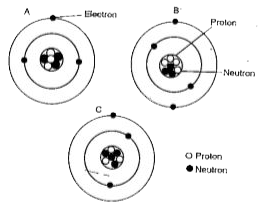What is atomic nucleus? Who discovered it? What are atomic number and mass number? Explain with illustrations.
Step-by-Step Solution
Step 1: Definition of Atomic Nucleus
The atomic nucleus is the central core of an atom, containing protons and neutrons. It is a small, dense region at the center of the atom, where most of the atom's mass is concentrated.
Illustration:
- Draw a circle to represent the nucleus.
- Inside the circle, label the components: "Protons" (positively charged particles) and "Neutrons" (neutral particles).
- Surround the nucleus with a larger circle representing the electron cloud.
Step 2: Discovery of the Atomic Nucleus
The atomic nucleus was discovered by Ernest Rutherford in 1911 through his gold foil experiment. He found that atoms consist of a small, dense nucleus surrounded by electrons.
Step 3: Definition of Atomic Number
The atomic number (Z) of an element is defined as the number of protons present in the nucleus of an atom of that element. It determines the identity of the element.
Illustration:
- For example, if we take Carbon (C), its atomic number is 6, meaning it has 6 protons in its nucleus.
Step 4: Definition of Mass Number
The mass number (A) of an element is the total number of protons and neutrons in the nucleus. It is calculated as:
A=Z+N
where N is the number of neutrons.
Illustration:
- For example, Lithium (Li) has an atomic number of 3 (3 protons) and a mass number of 7. Therefore, it has:
N=A−Z=7−3=4
This means Lithium has 4 neutrons.
Summary
- Atomic Nucleus: The center of an atom containing protons and neutrons.
- Discovered by: Ernest Rutherford.
- Atomic Number (Z): Number of protons in the nucleus.
- Mass Number (A): Total number of protons and neutrons in the nucleus.
The atomic nucleus is the central core of an atom, containing protons and neutrons. It is a small, dense region at the center of the atom, where most of the atom's mass is concentrated.
- Draw a circle to represent the nucleus.
- Inside the circle, label the components: "Protons" (positively charged particles) and "Neutrons" (neutral particles).
- Surround the nucleus with a larger circle representing the electron cloud.
The atomic nucleus was discovered by Ernest Rutherford in 1911 through his gold foil experiment. He found that atoms consist of a small, dense nucleus surrounded by electrons.
The atomic number (Z) of an element is defined as the number of protons present in the nucleus of an atom of that element. It determines the identity of the element.
- For example, if we take Carbon (C), its atomic number is 6, meaning it has 6 protons in its nucleus.
The mass number (A) of an element is the total number of protons and neutrons in the nucleus. It is calculated as:
A=Z+N
where N is the number of neutrons.
- For example, Lithium (Li) has an atomic number of 3 (3 protons) and a mass number of 7. Therefore, it has:
N=A−Z=7−3=4
This means Lithium has 4 neutrons.
- Atomic Nucleus: The center of an atom containing protons and neutrons.
- Discovered by: Ernest Rutherford.
- Atomic Number (Z): Number of protons in the nucleus.
- Mass Number (A): Total number of protons and neutrons in the nucleus.
Topper's Solved these Questions
- ATOMS AND NUCLEIBOOK - PRADEEPCHAPTER - ATOMS AND NUCLEIEXERCISE - Questions Long 5
1 Videos
- ATOMS AND NUCLEIBOOK - PRADEEPCHAPTER - ATOMS AND NUCLEIEXERCISE - Questions Long 7
1 Videos
- ATOMS AND NUCLEIBOOK - PRADEEPCHAPTER - ATOMS AND NUCLEIEXERCISE - Questions short 17
1 Videos
- COMMUNICATION SYSTEMSBOOK - PRADEEPCHAPTER - COMMUNICATION SYSTEMSEXERCISE - MODEL TEST PAPER-2
9 Videos
Similar Questions
Knowledge Check
The number of nucleons in an atom of atomic number Z and mass number A is
AzeroBZCA-ZDAThe number of electrons in an atom of atomic number Z and mass number A is
AzeroBZCA-ZDAWhat is the valency of the element with atomic number 36 and mass number 84 ?
A2B4C0D3
What is the atomic number of this element?
View SolutionWhat is the difference between mass number and atomic mass?
View SolutionFor stability in nucleus of atoms with lower atomic number:
View SolutionA uranium nucleus (atomic number 92, mass number 231) emits an α-particle and the resultant nucleus emits a β-particles. What are the atomic and mass numbers of the final nucleus? .
View SolutionWrite the complete symbol for
(i) the nucleus with atomic number 56 and mass number 138
(ii) the nucleus with atomic number 26 and mass number 55
(iii) the nucleus with atomic number 4 and mass number 9.
View Solution

